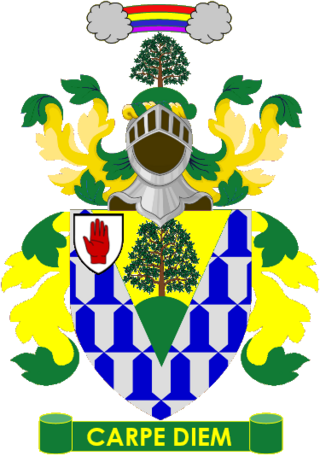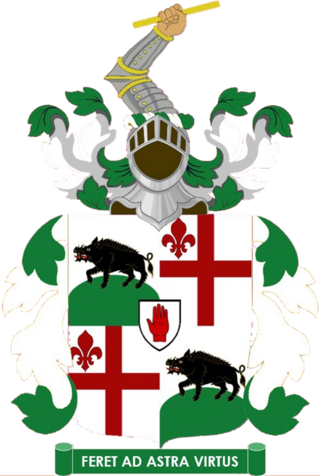
There have been two baronetcies created for persons with the surname Arthur, both in the Baronetage of the United Kingdom. As of 2014 both creations are extant.
There have been four baronetcies created for persons with the surname Leslie, one in the Baronetage of Nova Scotia, one in the Baronetage of Ireland, one in the Baronetage of Great Britain and one in the Baronetage of the United Kingdom. Three of the creations are extant as of 2010.

The Wigan Baronetcy, of Clare Lawn in Mortlake in the County of Surrey and Purland Chase in Ross in the County of Hereford, is a title in the Baronetage of the United Kingdom. It was created on 9 March 1898 for Frederick Wigan, a Director of the North London Railway. The presumed 6th Baronet, listed in Debrett's Peerage (2015) as the son of the 5th Baronet, has not successfully proven his succession and is consequently not on the Official Roll of the Baronetage.

There have been four baronetcies created for persons with the surname Hope, three in the Baronetage of Nova Scotia and one in the Baronetage of the United Kingdom. As of 2010 one creation is extant, one dormant and two extinct.
There have been two baronetcies created for persons with the surname Joseph, both in the Baronetage of the United Kingdom. One creation is extinct while one is extant.
There have been nine baronetcies created for persons with the surname Moore, two in the Baronetage of England, one in the Baronetage of Ireland, two in the Baronetage of Great Britain and four in the Baronetage of the United Kingdom. As of 2014 two creations are extant and one is considered dormant.

The Brisco Baronetcy, of Crofton Place in the County of Cumberland, is a title in the Baronetage of Great Britain. It was created on 11 July 1782 for John Brisco, with remainder, failing male issue of his own, to his brother Horton and the heirs male of his body. Brisco had earlier served as Sheriff of Cumberland. The title descended from father to son until the death of his great-great-grandson, the fifth Baronet, in 1922. The late Baronet was succeeded by his first cousin, the sixth Baronet. He died childless and was succeeded by his first cousin, the seventh Baronet. This line of the family failed on the death of the latter's son, the eighth Baronet, in 1995. The late Baronet is believed to have been succeeded by his first cousin, the presumed ninth and present holder of the title who lives in Southland, New Zealand. Campbell Howard Brisco is the son of Gilfrid Rimington Brisco, younger brother of the seventh Baronet. However, he has not successfully proven his succession to the baronetcy and is therefore not on the Official Roll of the Baronetage, with the baronetcy considered dormant. For more information, follow this link.
There have been four baronetcies created for persons with the surname FitzGerald, one in the Baronetage of Ireland and three in the Baronetage of the United Kingdom.

There have been three baronetcies created for persons with the surname Munro, one in the Baronetage of Nova Scotia and two in the Baronetage of the United Kingdom.
There have been four baronetcies created for persons with the surname O'Brien, one in the Baronetage of Ireland and three in the Baronetage of the United Kingdom.

The Kellett Baronetcy, of Lota in Cork, is a title in the Baronetage of the United Kingdom. It was created on 6 August 1801 for Sir Richard Kellett, with remainder to the heirs male of his father Richard Kellett. On the death of the second Baronet in 1886 the title passed to the third Baronet, a descendant of Henry Kellett, younger brother of the first Baronet. However, he did not assume the title until 1906. The presumed fifth and sixth Baronets did not successfully prove their succession and were not on the Official Roll of the Baronetage. The presumed seventh Baronet has also not successfully proven his succession and is not on the Official Roll of the Baronetage, with the baronetcy considered dormant since 1966.

The Currie Baronetcy is a title in the Baronetage of the United Kingdom. It was created on 11 January 1847 for Frederick Currie, Foreign Secretary to the Indian Government and a member of the Supreme Council of India. He was a grandson of William Currie (1721–1781), nephew of William Currie (1756–1829), who was Member of Parliament for Upper Gatton and Winchelsea, and the brother of Vice-Admiral Mark John Currie.

The Leeds Baronetcy, of Croxton Park in the County of Cambridge, is a title in the Baronetage of the United Kingdom. It was created on 31 December 1812 for George Leeds. He was an equerry to Prince Augustus Frederick, Duke of Sussex. The Croxton Park estate in Cambridgeshire had been in the Leeds family since circa 1568. As of 2011 the presumed ninth and present Baronet, a resident of Canada, has not successfully proven his succession and is not on the Official Roll of the Baronetage.

The Chetwynd Baronetcy, of Brocton Hall in the County of Stafford, is a title in the Baronetage of Great Britain. It was created on 1 May 1795 for Sir George Chetwynd, Kt., of Brocton Hall, Staffordshire, for many years Clerk to the Privy Council. The second Baronet was member of parliament for Stafford and High Sheriff of Warwickshire in 1828. The fourth Baronet served as High Sheriff of Warwickshire in 1875. As of 13 June 2007 the presumed ninth Baronet has not successfully proven his succession and is therefore not on the Official Roll of the Baronetage, with the baronetcy dormant since 2004.
The Duntze Baronetcy, of Tiverton in the County of Devon, is a dormant title in the Baronetage of Great Britain. It was created on 8 November 1774 for John Duntze, an Exeter wool merchant and Member of Parliament for Tiverton. The family was of German descent. The presumed seventh Baronet never successfully established his claim to the title. Likewise, as of 13 June 2007 the presumed eighth and present Baronet has also not successfully proven his succession and is therefore not on the Official Roll of the Baronetage, with the baronetcy considered dormant since 1985.
There have been two baronetcies created for persons with the surname Hawley, one in the Baronetage of England and one in the Baronetage of Great Britain.

The Wardlaw Baronetcy, of Pitreavie in the County of Fife, is a title in the Baronetage of Nova Scotia. It was created on 5 March 1631 for Henry Wardlaw, Chamberlain to Anne of Denmark, consort of James VI, with remainder to heirs male whatsoever. He had acquired Pitreavie in 1606 and this was erected into a barony in 1627. As of 13 October 2008 the presumed twenty-first and the twenty-second Baronets have not successfully proven succession and are therefore not on the Official Roll of the Baronetage, with the baronetcy considered dormant since 1983. The poet Elizabeth, Lady Wardlaw was the wife of the fourth Baronet.
There have been four baronetcies created for persons with the surname Hay, all in the Baronetage of Nova Scotia. Two creations are extinct, one dormant and one extant. A fifth baronetcy in the Jacobite Peerage, although theoretically extant, is not recognised by the Lyon Office.
There have been four baronetcies created for persons with the surname Seton, all in the Baronetage of Nova Scotia. As of 2008 one creation is extant, one dormant and two extinct.

The Mackenzie baronetcy, of Coul (Coull) in the County of Ross, was created in the Baronetage of Nova Scotia on 16 October 1673 for Kenneth Mackenzie. His father Alexander Mackenzie of Coul was the illegitimate son of Colin Cam Mackenzie, 11th of Kintail, and half-brother of Kenneth Mackenzie, 1st Lord Mackenzie of Kintail, ancestor of the Earls of Seaforth, and of Sir Roderick Mackenzie, ancestor of the Earls of Cromarty. The 3rd Baronet was involved in the Jacobite rising of 1715. He was attainted with the baronetcy forfeited.











